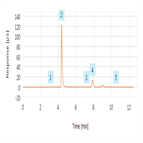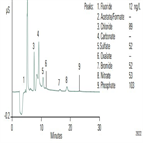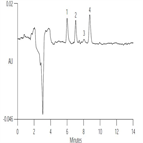Find methods for your needs
Refine by Feature
Displaying 1-5 of 5 results for Tag: semiconductor
AN72481: Trace Anions by Single Pass AutoNeutralization and Ion Chromatography (IC): Anions in 5% NaOH
Instrument Type: ICTrace anions determinations in caustic solutions require high dilution to minimize column overload by the caustic sample. However, the high dilutions required prevent analysis of trace anionic contaminants. Here a single pass approach to neutralize the base sample is demonstrated using both suppressors run in recycle mode. The run time was reduced from 45 min in the previous version of this application, AN 93 using “Park and AutoNeutralize” to 12 min. This application is demonstrated on a 5% (w/w) sodium hydroxide sample. An ICS-6000 can be used for this application.
TN112: Determination of Trace Anions in Ultrapure Water Using Capillary Ion Chromatography: LARGE LOOP INJECTION
Instrument Type: ICIn technical note TN112, trace anion determinations in ultrapure water by capillary IC are discussed. Both large volume direct injection using a large loop and using a concentrator column are discussed. Additionally installation tips are discussed.
AU155: Determination of Cations and Amines in Hydrogen Peroxide by Ion Chromatography Using a RFIC (Reagent-Free) System
Instrument Type: ICHydrogen peroxide is an essential chemical in the fabrication of integrated circuit and microcircuit devices. Maximum allowable contaminate levels for semiconductor grade hydrogen peroxide can be as low as <100 ppt (ng/L) per individual inorganic cation. This application uses an IonPac CS17 column to determine trace cations and amines in hydrogen peroxide with a large-loop injection. The CS17 column separates amines without the organic solvent eluent modifier needed for separating amines when using older cation-exchange ion-chromatography (IC) columns.
AN131: Determination of Transition Metals at PPT Levels in High-Purity Water and SC2 (D-clean) Baths
Instrument Type: ICSemiconductor cleaning solutions used to remove potentially damaging transition metal contamination are monitored to assess cleaning efficiency. Here trace concentrations (ng/L) of transition metals in semiconductor cleaning solutions and deionized water are separated using the strong complexing agent, pyridine-2,6-dicarboxylic acid (PDCA), on an IonPac CS5A column optimized with anion- and cation-exchange chemistry. Then a post-column derivitization agent, 4-(2- pyridilazo)resorcinol (PAR), is added to displace PDCA and to facilitate detection at 520–530 nm.
Semiconductor carbonated water
Instrument Type: ICHigh pressure 18 MΩ-cm deionized water is used to clean tools and provide coolant during dicing operations of semiconductor devices. To minimize static charge buildup which may damage devices, some manufacturers "reionize" or aerate the deionized water with high purity carbon dioxide gas to increase the ionic content, thus reduce the resistivity and minimize static discharge damage. Here ppb anion concentrations are determined in carbonated deionized water using large loop injection (40 µL) onto IonPac AS15 column with a hydroxide gradient and suppressed conductivity detection.




